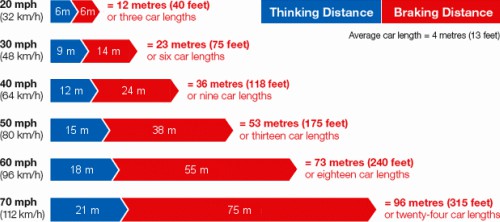What are average stopping distances?
To begin, it’s important to remember this equation: stopping distance = thinking distance + breaking distance.

What is thinking distance?
This is pretty self-explanatory, the ‘thinking’ distance is how long it takes for the driver to react to hazard and apply the brake.
The Highway Code has provided the following thinking distances at different speeds:
Speed (MPH) – Thinking Distance (before reacting)
20 – 6 metres
30 – 9 metres
40 – 12 metres
50 – 15 metres
60 – 18 metres
70 – 21 metres
What is the braking distance?
This is the second part of the equation of what makes up the overall stopping distance. It involves how far your car travels while you’ve got your foot on the brake attempting to bring it to an emergency stop.
These are the official braking distances provided by the Highway Code:
Speed (mph) – Braking Distance
20 – 6 metres
30 – 14 metres
40 – 24 metres
50 – 38 metres
60 – 55 metres
70 – 75 metres
Remembering stopping distances
The topic of stopping distances is frequently asked in the theory test, and if you’re someone who struggles with remembering them – don’t worry, we’ve got a special trick for you so you pass your theory test with gold stars!
Revealed here:
All you need to do is multiply the speed by intervals of 0.5, starting with 2. That’ll give you the stopping distance in feet, which is acceptable for the theory test.
20mph x 2 = 40 feet
30mph x 2.5 = 75 feet
40mph x 3 = 120 feet
50mph x 3.5 = 175 feet
60mph x 4 = 240 feet
70mph x 4.5 = 315 feet
What other factors affect stopping distance
Nowadays, we are fortunate enough to have the support of ABS systems and better tyres which aid us in stopping a lot quicker. Which is why people question the stopping distances in the Highway Code, however, these features will only affect the braking distance.
 1. Weather
1. Weather
As we experience a lot of bad weather here in the UK, it’s important to be mindful of what these conditions can do to the road surfaces you’re travelling on.
It can cause poor visibility; therefore, this can mean the driver takes longer to react – increasing his/her thinking distance. On the other hand, slippery roads caused by rain, snow or ice will also extend the braking distance.
Furthermore, this has shown through research gathered, that braking distances can be doubled in wet conditions and extended to 10x longer on snow and ice.
2. Road Condition
A road might be particularly greasy if it has rained after a period of hot weather, or if an oil has been spilt on it.
Be prepared for black ice on cold days, and watch out for loose surfaces such as gravel. All these could make it difficult to stop in a hurry.

3. Driver Condition
Everyone forgets this factor, yet it’s the most obvious one. The person who is behind the wheel of the car plays a crucial part in the thinking distance – and that can play a major role in the overall stopping distance.
Numerous things can manipulate this, such as a driver’s age, how awake they are and if they’ve consumed any drugs or alcohol.
Also, the key one is using a mobile phone. This causes drivers to concentrate on this rather than what is going on around them; just a few seconds glancing at your phone can add a football pitch to your overall stopping distance at motorway speeds.
Other distractions in the car can be loud music and passengers – all of which can affect the thinking time before you apply pressure on that brake pedal.
4. Car Condition
In terms of the condition of the car itself, this can majorly impact the car’s stopping distance e.g. there would be a difference found in stopping distance depending on the type of tyres you have.
Research has found that tyres on the legal limit of 1.6mm tread can need an extra 60% more road to stop compared to brand new tyres.
Under-inflated tyres will also have an impact on stopping distances, as will cars with poorly maintained brakes. Check your brake pads to make sure they are still in good condition, and test your brakes after driving through the water to check for moisture left between the pads and discs.
We hope this has given you a better understanding of stopping distances and has shown you the importance of making sure we stop within a good time.
For more CarCliq guides click here.